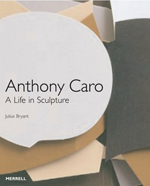Occasional Interruptions
Of Blue
THREE ART BOOKS

Anthony Caro. A Life in Sculpture is a
beautifully produced hardback from Merrell Publishers, full of surprises
and insight into this important sculptor’s work. There are revealing shots of the studio where he works, an insightful introduction, and a long and fruitful interview too; but the real insight is the work itself - its variedness, it’s ambition, it’s
clarity and complexity.
I had Caro down as a sculptor who mainly made gaunt, brightly-painted
steel abstracts. I was wrong. For starters, Caro uses many materials
other than metal:
his work is full of clay and wood and stone. The work is no longer either abstract
nor gaunt, instead Caro has adopted a rich, semi-figurative/narrative approach
to his subjects. True, there are often no figures actually present in the work
[though occasionally there are], but there are objects and traces, often gathered
on a table or plinth of some sort. Or there are empty towers and buildings,
sculptures themselves, for strange purposes; for us to explore and admire,
truly ‘tower[s] of discovery’. And there are vast installations - halls or rooms full of sculptures, carefully placed and juxtaposed, tackling the vast themes of ‘The Last Judgment’ or ‘The Trojan War’.
Caro is honest and open about shifts and changes in his working methods and
subjects, and this comes through in the work. A Life in Sculpture is a superb
celebration of this most intriguing and intelligent artist.
If Caro has got more complex with age, it is clear from another Merrel book,
William Scott. Paintings and Drawings, that William Scott didn’t. That isn’t
a criticism, for throughout his life Scott struggled to simplify and catch
the essence of his subject. Nudes became a series of gestural lines, harbours
became a block [the wall] intruding into a field of colour [the sea], pots
and pans became silhouetted or just hinted at.
Rooted in 1950s abstraction, and with nods to Matisse and pattern-making, these
paintings are rich and almost zen-like in their minimal presence. Green beans
glow on a white plate, a mug stands solid and yet ethereal against smudged
white, pears stand upright and alert on a dark tablecloth. Yet there is still
richly textured paint here, and the artist’s strange spectrum - rooted in the
yellows, ochres, creams and oranges [with occasional interruptions of blue]
of earlier work.
This book seems to have been published on the occasion of an exhibition at
the Irish Museum of Modern Art, so it’s also a kind of catalogue. Michael Tooby, who used to run Tate St Ives writes an essay, although I prefer Simon Morley’s piece, where he explores ‘Scott after Modernism’; there’s also a useful and interesting set of statements by Scott himself as well as some reprinted reviews. I wish there were more illustrations of later work, but one can’t argue with the breadth and overview of what’s reproduced here - this is a fascinating and overdue reconsideration of Scott’s
work.
I wanted to contrast these two books with Nicholas Zurbrugg’s Art, Performance,
Media. 31 Interviews from the University of Minnesota Press, and discuss
the way new media have often replaced paint and metal, and how exciting it
all is. But, to be honest, the book seems tired and historical: a product of
the last decade and not the cutting-edge future it purports to be. Zurbrugg
died in late 2001, having prepared this book for publication, yet it’s
taken another three years for it to surface; this delay may have something
to do with my response, but I suspect not.
It’s more to do with the fact that I’ve read many of these when they first appeared in magazines or anthologies [in fact I published three of them], and that they’re mainly the usual suspects: John Cage, Laurie Anderson, Kathy Acker, Brion Gysin, Burroughs, Meredith Monk, Bill Viola and so on. The interviews are good, but of their time, they’re not deep or general enough to stand up as some kind of overview, they’re more snapshots from the past. And it’s a past that is, I feel, fading from us: we don’t
yet know what will last from the scramble of new media that turned up late
in the last century.
© 2004 Rupert Loydell